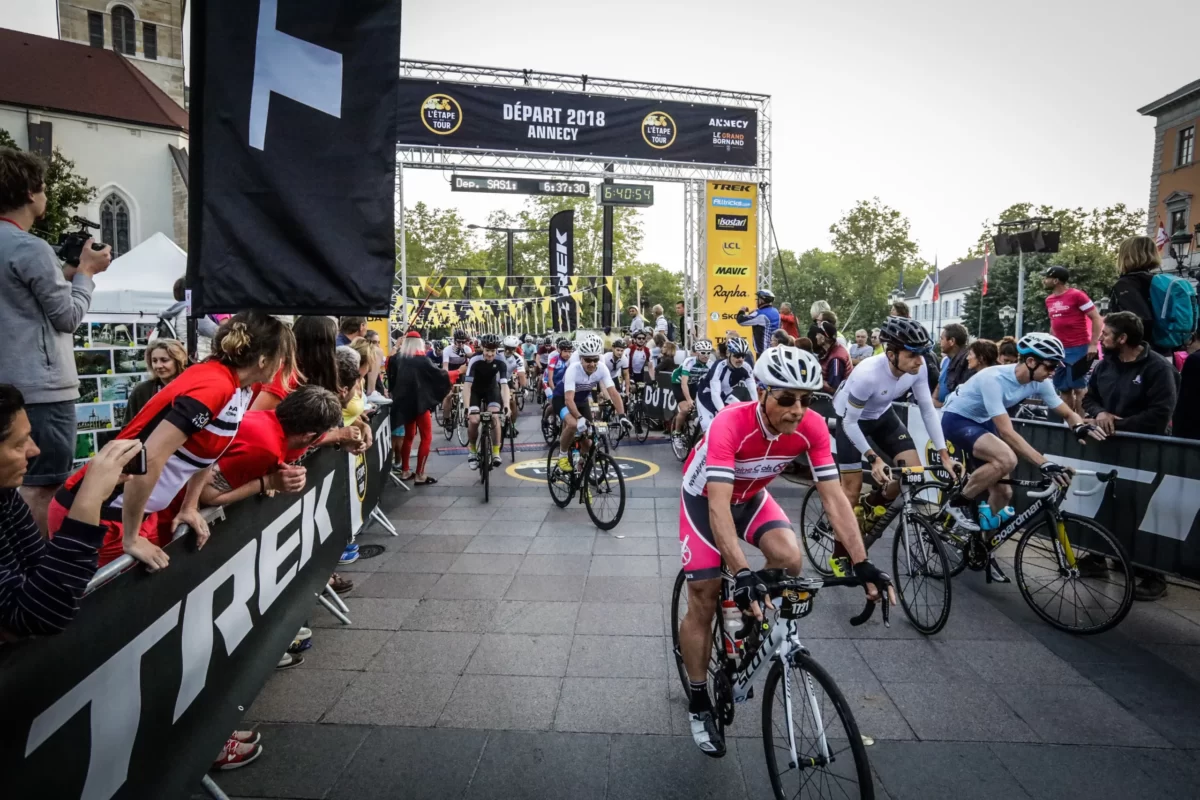
Signed up for the Etape du Tour in a moment of enthusiasm and now wondering what you have let yourself in for?
If you are a first-timer at the Etape, and a relatively inexperienced cyclist, this training guide is for you. Follow it carefully and you will give yourself the best possible chance of reaching the finish line on July 9th.
Introduction to the Etape du Tour
The Etape du Tour offers amateur riders the opportunity to compete in an actual stage of the Tour de France, under closed-road conditions. This makes it the approximate equivalent of playing football on the hallowed turf of one of the world’s most famous stadiums. The event thus attracts many people who wouldn’t normally participate in a cycling race, but are keen to experience at least once what they see on their televisions in July every year. If you are one of these, you are right: it’s a fantastic, unforgettable experience!
The Etape is always one of the mountain stages of the current year’s Tour, including iconic climbs and stunning scenery in a route that is already tough for the professionals and is extremely challenging for those unaccustomed to cycling in the mountains. The 2023 route includes four medium-sized climbs and two major ones, with as many descents. There’s relatively little flat road. Watch the video here for our presentation of the course.
The Etape du Tour is limited to 14,000 participants and always sells out very quickly. The event attracts the best amateur riders from the world over, and competition is fierce. Only the best-trained cyclists can hope to finish anywhere near the podium. Simply to finish is an exploit to be proud of: literally thousands of riders abandon every year.
Don’t let it happen to you!
Read on to learn how to train so that you have the best chance of success on the day. Watch here for a video presentation.
1. What does it take to finish the Etape?
Inexperienced riders should expect to take from 9 to 12 hours to finish the 152km and 4,000m of climbing between Annemasse and Morzine. Strong, well-trained amateurs will take from 6 to 8 hours, while the winner will take around 5h15 to 5h30. Note that even for the best, this is twice the time it takes to finish a marathon.
It is a challenging ride by any standards, and especially so if you are relatively new to cycling. Assuming that your goal is essentially to finish, without any particular concern for the time it takes, this is what it will take:
- Physical fitness. Don’t underestimate the level of fitness required. You may be fit from another sport, but you will still need to create the specific cycling fitness to make it up all the climbs.
- Skills for Alpine descents. Descending is a crucial skill for professionals and amateurs alike, although naturally at different levels. To stay safe, you must learn good descending technique.
- Ability to fuel your ride. You will expend an enormous amount of energy riding the Etape. If you don’t develop the ability to fuel your ride you are most unlikely to finish.
- Mental strength. For many people, it will be the hardest physical challenge they have ever undertaken. Especially on the final climb, it will take mental strength to keep going when all you want to do is stop.
So let’s see how to prepare for this.
2. How to train: the principles
The best training plan for you is one that has been designed specifically for you. If you expect to take 10-12h to finish, you need a very different plan to someone who is aiming to finish in 6h. The closer to the front, the more like a race; the closer to the back, the more it becomes a pure endurance ride. The training is not the same.
Since we don’t know you, we can’t give you a detailed training plan. What we can do is provide a framework and a set of guidelines for you to adapt to your needs.
The key principles behind a training plan aimed at finishing the Etape du Tour are:
- Your commitment to make training a priority. This should go without saying, but if you want to finish the Etape, you must commit to a serious effort of preparation.
- Be consistent. You should be on your bike every week between now and July 9th. Your training load will vary, but these variations should be deliberate as you go through a load-recovery cycle. You should still train during the recovery weeks (although much less). Any extended periods without training will lead to stagnation and even detraining.
- Build a strong aerobic base, so you can ride hard for several hours without having to ease off. To do this, we recommend you train mostly at low intensity. It’s important to understand that training at low intensity provides the endurance adaptations you need without adding unnecessary fatigue, thus allowing you to train more.
- Build your pain tolerance. Endurance is “the struggle to continue against a mounting desire to stop”. There’s no escaping the fact that the Etape du Tour is going to make you suffer. The better you can train yourself to tolerate the discomfort as it becomes more and more pressing, the more likely you are to finish.
- From April onwards, do as much climbing as possible, mostly at low intensity. As you get closer to the event you should do some of the climbs at race pace, especially towards the end of your rides.
- Increase the load progressively, then recover, to allow your body to adapt and get stronger. Remember, hard training actually breaks you down and makes you weaker! You only get stronger when your body has the time to recover, adapt and rebuild. There should be a big difference between your hardest and your easiest training weeks.
- Include exercises to develop your technical skills, such as cornering, descending, and eating and drinking on the bike.
Now that the principles are clear, in the next section we are going to explain how to create your training plan.
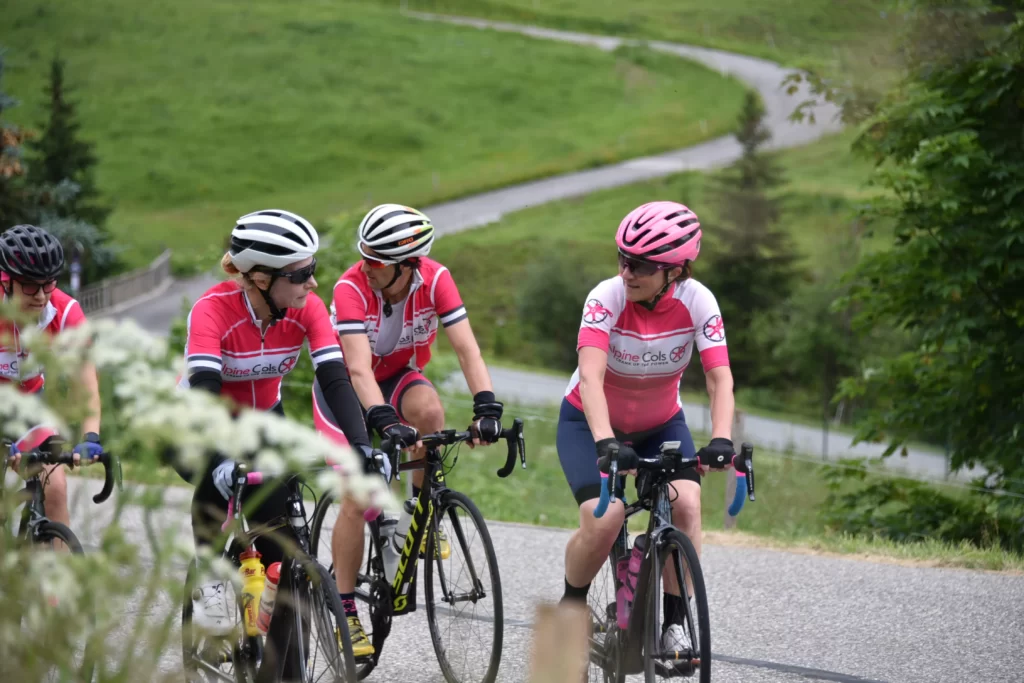
Photo: Alpine Cols
3. Your Training Plan: Overview and Structure
Our framework training plan is attached as the last two pages of these Guidelines. You can download it here.
It begins on January 1st, giving you six months to prepare for the event. It’s really important that you ride regularly throughout this period. If you can’t ride outside, you will have to compensate by riding indoors on a turbo trainer (it may be possible to hire a turbo trainer if you don’t want to buy one).
The framework includes three phases: Preparation, or Training to Train (January to March), Pre-Competition (April to June) and Taper (the last two weeks before the Etape). Each phase is then broken down into 4-week cycles including 3 load weeks and 1 recovery week, with a target training load for each week. If you are over 50, instead of a 4-week cycle we recommend a 3-week cycle of 2 load weeks and 1 recovery week, because you will take longer to recover than a younger person.
It’s important to understand that such a structure is essentially arbitrary and takes no account of the total stress (life stress + training stress) you will be under on any particular day. If you feel stressed and tired, and/or if you have sore muscles, it would often be better either to take a very easy day or not to train at all until you have recovered.
Hard training breaks you down: you only get stronger during recovery!
4. Customising the framework for you
Step 1: Plan your training time per day
It’s best to take a pragmatic approach here. Pull out a calendar and mark off all your known constraints between today’s date and the Etape du Tour on July 9th. These might include work, travel, family commitments or anything else that will prevent or severely limit your training on any particular day.
Next, go day by day and mark the amount of time you are ready to dedicate to training. Be realistic: there’s no point in starting out with a plan that will fail in the first two weeks. At this point, it’s a good idea to check for agreement with your partner and family: you might save a lot of misunderstandings and arguments later.
If your goal is simply to finish the Etape (as opposed to riding it as fast as possible), there’s no need to become single-minded, so long as you keep up a minimum, consistent level of training. It’s hard to give an exact figure that would apply to everybody, but you won’t go far wrong if you target 5h per week (on average) from now to the end of March, and then increase this to 8h per week (on average) for the last three months.
Unless you are retired or have a different work pattern, most of your free time will be at the weekends. It’s not advisable, however, to ride only once or twice a week. It obviously helps if you can ride to and from your workplace, but if this is not possible you will need to find another way to ride at least once mid-week. Doing it at home on a turbo trainer is fine.
Assuming you are working Monday to Friday, weekly schedules for hard and easy weeks during the Preparation phase (January – March) and the Pre-Competition phase (April to June) could look something like this:
The end result of this work will be your own, personal and unique training plan, including the number of hours you plan to train day by day, every day between now and July 9th. This may seem like overkill but believe an experienced coach: it will give you the best chance of reaching your goal of earning a coveted Finisher’s Medal at the Etape du Tour!
Remember the old adage: “Fail to plan equals plan to fail”.
Your plan is almost certain to need updating several times between now and July, as additional constraints such as family or work events get added. When this happens, adapt the plan accordingly. If the new constraint only affects a single day, you can either skip the planned training session altogether or re-plan it for another day. If the new constraint affects several days, it may make sense to re-plan the periodisation so that you train hard in the days leading up to the constraint and then recover during the constraint period when you can’t train anyway.
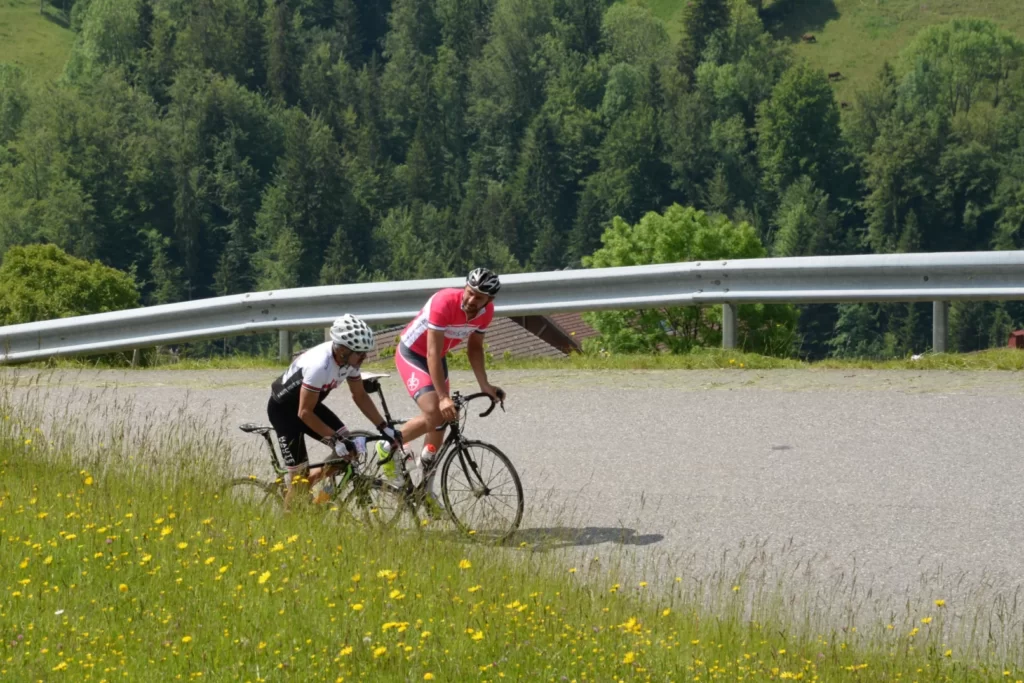
Photo: Alpine Cols
Step 2: Plan your workouts
Now you have the time available to train on a day-by-day basis, you can plan your detailed workouts. The minimum time for a cycling workout is 30 minutes (anything less is best devoted to a Pilates or Yoga session intended to develop your mobility and flexibility). Based on your time available, place the following workouts as best you can on your schedule.
Preparation phase
During the Preparation phase (from January to March) a typical high volume (hard) week should include the following workouts:
- Low intensity long ride, starting at 1-2hrs and progressing to 4hrs. This ride should feel easy (at least for the first 2h). You should be able to talk normally throughout and you should never be out of breath. Don’t worry, you will ride faster than this at the Etape, but training at this low intensity will give you all the aerobic adaptations you need without adding unwanted fatigue, thus enabling you to complete the other training sessions as well.
- Low intensity medium ride 1-2 hrs, progressing to 3hrs
- Low intensity ride 1-2 hrs
- Hard interval sessiong. 4 x [5′ hard – 5′ easy], for a total of 20’ hard riding in 4 intervals of 5’ each. Do this on your turbo or outside on a climb with a 5-7% gradient. Warm up first for at least 15′. The effort should feel about 7 on a scale from 1-10 where 1 is super easy and 10 is a maximum, all-out effort for the 5’. You should be able to finish each 5′ interval feeling you could go on for at least another 5′. After 6 weeks add a fifth interval.
- Mobility & flexibility (e.g. Pilates or Yoga), 15-30 minutes
- Recovery ride 1hr
- Mobility & flexibility (e.g. Pilates or Yoga), 15-30 minutes
The suggested sessions are in order of priority. Do as many as you can but in this order. If you can only manage the first 5 sessions that’s fine.
Still during the Preparation phase (from January to March) a typical low volume (easy) week should look like this:
- (Very) low intensity ride, starting at 1hr and progressing to 1-2hrs
- Second very low intensity ride, 1 hr
- Third very low intensity ride, 1 hr
These easy, recovery weeks are essential; do not be tempted to skip them. It is during these weeks that your body rebuilds and regenerates, becoming stronger. Hard training breaks you down: only recovery allows you to get stronger.
Pre-Competition phase
During the Pre-Competition phase (from April to June) a typical high volume (hard) week should include the following workouts:
- Low intensity long ride, 4-5hrs, progressing to 6hrs in one ride by mid-June, with as much climbing as possible. This ride should feel easy (at least for the first 2h). You should be able to talk normally throughout and you should never be out of breath.
- Tempo interval sessiong. 2-3 x 20’ at race pace. The pace should feel about 5 on a scale from 1-10 where 1 is super easy and 10 is maximum. You should be able to finish each 20′ interval feeling you could go on for another 20′. Do this on climbs during a 2-4hr ride. Alternative: club ride 2/month in May and June
- Low intensity long ride, 2-3hrs, progressing to 5hrs, including climbs
- Mobility & flexibility (e.g. Pilates or Yoga), 15-30 minutes
- Hard interval session 5-6 x [5′ hard – 5′ easy]. Do this on your turbo or outside on a climb with a 5-7% gradient. Warm up first for at least 15′. The effort should feel about 7 on a scale from 1-10 where 1 is super easy and 10 is a maximum, all-out effort for the 5’. You should be able to finish each 5′ interval feeling you could go on for at least another 5′.
- Mobility & flexibility (e.g. Pilates or Yoga), 15-30 minutes
- Recovery ride 1-2hrs (flat)
Again, the suggested sessions are in order of priority. Do as many as you can but in this order. If you can only manage the first 5 sessions that’s fine.
During the Pre-Competition phase (from April to June) a typical low volume (easy) week should look like much the same as in the Preparation phase:
- (Very) low intensity ride, starting at 1hr and progressing to 1-2hrs
- Second very low intensity ride, 1 hr
- Third very low intensity ride, 1 hr
Do not be tempted to skip these easy recovery weeks: they are essential.
Taper phase
During the Taper phase it is too late to build any fitness, so hard training is pointless. Your objective in this phase is to recover and taper your training in such a way that you maintain your fitness while eliminating your accumulated fatigue.
You cannot just stop training because that will result in losing fitness.
Different people respond differently to a taper period and there are no hard-and-fast rules, but you won’t go far wrong if you reduce your training load by 25-30% for the last week of June and by as much again for the first week of July.
Listen carefully to your body and if you feel tired train less. You will gain more by eliminating the accumulated fatigue than by forcing your unwilling body into yet another long ride.
5. Developing your skills
The most important skills you need to finish the Etape du Tour successfully are descending (which is more technical as well as being much more dangerous than climbing); eating and drinking while cycling, and mental skills to keep you going when things get really tough. Let’s look at each of these in turn and how you can develop them during your training.
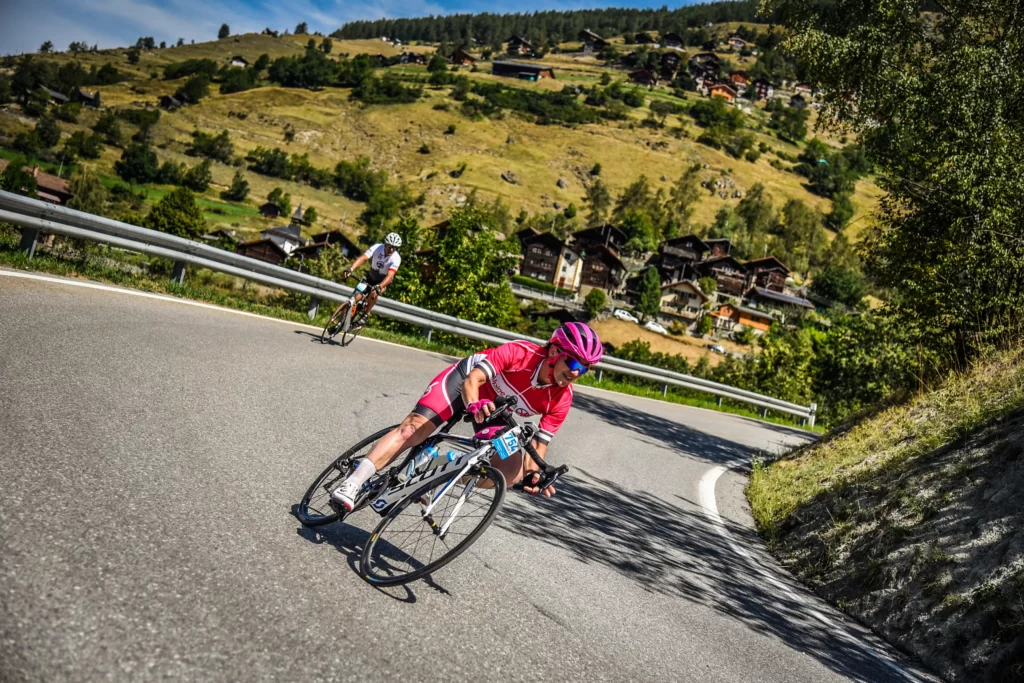
Photo: Sportograf
Descending
This is an important skill for several reasons. Firstly, experience tells us that most of the accidents will take place on the descents and will be caused by human errors.
Secondly, there’s a lot of descending: almost as much as there is climbing
Third, the roads are narrow and a good part of the descents are steep with tight and sometimes unpredictable turns. These can be very dangerous for inexperienced riders.
Fourth, you will be surrounded by many other people of varying skill levels. The more confidence you have in your own skills the more you can avoid trouble.
So it’s definitely worth the effort to learn. Like learning to ride a bike in the first place, or learning to ski, descending Alpine roads fast and safely is a skill that can only be learned with practice. This is obviously a bit of a challenge if you live far from the mountains, but there are some things you can do.
These are your options if you live in a flat area:
- Practice cornering at high speed at a suitable location near where you live. For obvious reasons, it’s best to do this in a safe area. It’s better than nothing but will only take you so far.
- Take a weekend trip to the nearest area with some significant hills, and practice there.
- Book a training camp in the Alps with someone like us that can teach you proper descending technique.
Eating and drinking while cycling
There’s a good reason why the feed stations at the Etape du Tour are always very crowded: it would be impossible to finish the Etape without eating and drinking on the way. If you have to stop cycling every time you want to eat and drink, you will waste a considerable amount of time. It’s therefore important to learn to eat and drink while cycling, on varied terrain, including climbs and descents.
You will have ample time to practice these skills during your long training rides. Get used to carrying two water bottles and drinking from one or the other on a frequent basis. As a rule of thumb, you should be drinking 500ml (one small bottle or 2/3 of a large bottle) every hour, perhaps a bit less in cold weather, more in hot weather.
On rides of less than 2h you don’t need an energy drink: water is fine. Over 2h it begins to be helpful to have an energy drink in one of your bottles in order to provide carbohydrates in liquid form. On rides over 3h it is important to do so.
There’s no need to eat anything on a ride of less than 2h, unless you feel hungry or weak. It is a good practice to have an energy bar in your pocket just in case. On rides exceeding 2h you should plan to eat at least 200 kcal per hour, starting early (so that you don’t get behind). It doesn’t really matter what you eat so long as it is predominantly carbohydrate and you can access it easily and eat while riding. Good choices include bananas, flapjacks, dried fruit (e.g. figs, apricots), biscuits, buns, new potatoes and of course commercial energy bars and gels. There are two places you can carry your food: either in your jersey pockets or in a special bag mounted on your top tube just behind the stem.
Mental skills
There will almost certainly be times on the Etape du Tour when you wonder why you are doing this and you have to battle an overwhelming desire to stop. For some people, this will first happen on the steep section of the col de la Ramaz (the penultimate climb); for many others it will happen on the col de Joux Plane, which is long and relentlessly steep.
If you follow our suggested training plan, you will automatically develop your mental strength as you increase the length of your rides and as you increase the difficulty of the interval sessions. But this may not be enough and you should spend some time thinking through what you will do during the event itself when all you want to do is stop. There are three main mental approaches that will help you to keep turning the pedals, all of which you should practice actively during your training:
- Have a clear reason why you are doing it. If there’s no good reason to push on to the finish, why bother? The reason must be meaningful and it must be yours. It might be for internal, personal reasons (such as your own enjoyment and satisfaction) or it might be for external reasons (to raise money for charity or to please or impress others): both internal and external motivations are valid (and certainly not mutually exclusive) although psychologists tend to agree that internal motivation is usually more powerful.
- Find ways to reduce your perception of effort. The harder it feels, the more you will want to stop. Therefore any technique that can make it feel less hard can help you keep going. Such techniques include distraction (thinking about something else, reciting a poem or a song, repeating a mantra) and focusing on something else (the rear-wheel hub of the rider in front of you, your breathing, your pedal stroke, the scenery…), or even smiling to yourself, which releases endorphins, the body’s natural pain-killers.
- Use positive self-talk. There’s research done on cyclists which shows it may be more effective to use the second person, so say things like “You are strong; I’m proud of you”; You’re doing great”; “You are here, living the dream”; “this is what you’ve been training for”. Whatever you choose to say, it will be more powerful if you have used it already in training.
Read here for more on mental strategies.
6. The essentials
Don’t overthink this or worry about missing any one training session. Your goal is to finish the Etape du Tour, not to win the Olympics, and the training you need is correspondingly relatively simple. In a nutshell, spend as much time as you can doing the following:
- Riding your bike, mostly at low intensity
- Doing long climbs (if necessary, simulate these on a turbo trainer)
- Learning to descend and corner at fairly high speeds
- Learning to drink and eat on your bike.
7. How can we help?
All of the Alpine Cols coaches have ridden the Etape du Tour multiple times and know the challenge extremely well. We can help you prepare in two complementary ways:
- Join our special Etape du Tour coaching camp in the Alps from 20 to 27 May. During the camp you will ride the actual route of the Etape (over two days) and benefit from a big block of training as well as one-on-one coaching on your technical skills. The coaches ride with you on their own bikes and use both observational feedback in real time and videos to help you improve. You will receive plenty of advice and tips for the event, and will leave confident in your ability to earn that famous Finisher’s medal.
- Ask us to coach you one-on-one between now and the event. Find out more about a coaching agreement with Alpine Cols.
Finally, we will be posting an article on “How to get your best result on the day” a bit closer to the event. Sign up for our newsletter (in the footer just below) and you will be notified when it’s posted.
Download our Guidelines and Framework training plan for the Etape
Contact Alpine Cols if you have any questions.
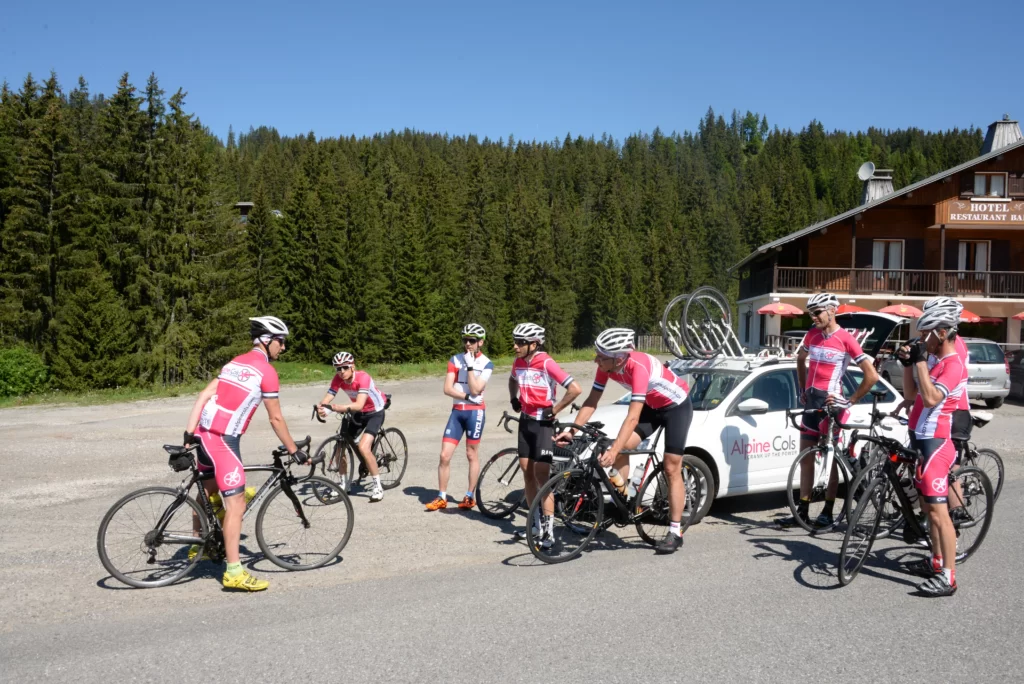
Photo Alpine Cols
Très détaillé, donne envie de faire le camp en Mai. Par contre, je compte 27 semaines entre le 1er janvier et le 9 juillet, date de l’EDT et sur votre plan, il y a 28 semaines. J’imagine que la semaine 26 et 27 que vous avez mis en intensité 3 sont un doublon. En tout cas, bravo pour les conseils et merci.
Merci de votre retour Sabine. Bien vu pour les semaines, effectivement une coquille! Ce sera corrigée…
Peut-être au plaisir de vous rencontrer au camp Etape du Tour en mai!
Inscription ETD ok, plan ok (difficile de faire plus precis que celui ci), reste plus qu’à acheter un vélo
Effectivement, difficile à s’entraîner sans un vélo !!! Faites le bon choix et bonne chance pour les mois à venir !